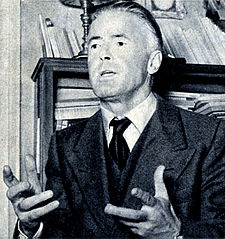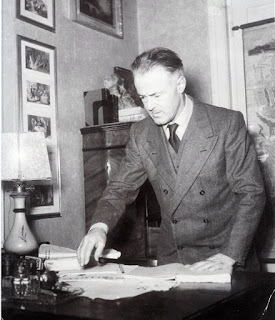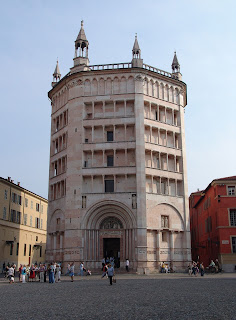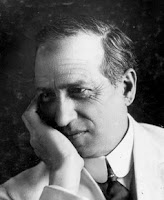Manager who transformed the New York Met
 |
Gatti-Casazza was manager at La Scala in
Milan before working in New York |
Giulio Gatti-Casazza, the impresario who as general manager transformed the Metropolitan Opera in New York into one of the world’s great houses, was born on this day in 1869 in Udine in northeast Italy.
The former general manager at
La Scala in Milan, Gatti-Casazza was in charge of the Met for 27 years, from 1908 to 1935.
In that time, having brought with him from Milan the brilliant conductor and musical director
Arturo Toscanini, he not only attracted almost all of the great opera singers of his era but set the highest standards for the company, which have been maintained to the present day.
Gatti-Casazza also pulled off the not inconsiderable feat of rescuing the Met from the brink of bankruptcy after the stock market crash of 1929.
The young Gatti-Casazza had studied engineering after leaving school, graduating from the Genoa Naval School of Engineering, yet the love of opera was in the family. His father was manager of the Teatro Comunale, the municipal theatre in
Ferrara, where they had moved when Giulio was young, and he succeeded his father in that role in 1893.
He proved very effective, combining his knowledge of opera with a natural gift for management. His success attracted attention and in 1898, at the age of just 29, he was recommended by the composer
Arrigo Boito as a suitable candidate to be general manager at
Teatro alla Scala - universally known as La Scala - in Milan.
 |
A photograph taken at a dinner held in honour of Gatti-
Casazza and Toscanini at the Hotel St Regis in New York |
Gatti-Casazza was appointed at the same time as Toscanini, also 29, was hired as principal conductor, having made his mark already in Buenos Aires and Turin.
At La Scala, he undertook a complete administrative overhaul and redefined the house’s purpose, turning it from a commercial theatre to a centre of excellence, dedicated to the advancement of the musical arts. It soon came to be seen as a temple of opera in Europe comparable with the opera houses of Paris and Vienna.
Again, his achievements were soon noted further afield, and in 1908 came an offer from Otto Kahn, chairman of the board of the Metropolitan Opera, to go to
New York.
Toscanini was persuaded to go with him, while another bonus was the opportunity to work again with
Enrico Caruso, the brilliant Neapolitan tenor who had been given his debut at La Scala by Gatti-Casazza in 1900. Caruso had been at the Met since 1903, hired by the Austrian impresario Heinrich Conried, Gatti-Casazza's predecessor as general manager.
 |
Gatti-Casazza with his first wife, the
soprano Frances Alda, in 1921 |
Early in their tenure, Gatti-Casazza and Toscanini arranged for the great composer
Giacomo Puccini, whose fame had been established by the success of
La Bohème and
Tosca, to oversee a production of
Madama Butterfly as well as commissioning him to write
La Fanciulla del West for Caruso and their Czech soprano Emmy Destinn. The opera had its world premiere at the Met in 1910.
Under Gatti-Casazza's leadership, the Met’s reputation grew exponentially and most of the world’s celebrated singers in the early 20th century were only too eager to appear there, including Frances Alda,
Amelita Galli-Curci, Lily Pons,
Giovanni Martinelli,
Beniamino Gigli, Titta Ruffo and Giacomo Lauri-Volpi.
Gatti-Casazza became the toast of the New York cultural scene, twice featuring on the cover of
Time Magazine as one of the first Italians to be afforded that honour.
Although he suffered a blow in 1915 when Toscanini decided to return to Italy, by far the biggest crisis to face Gatti-Casazza in New York was the
Wall Street Crash of 1929, which prevented a planned move of the company to a new home at the Rockefeller Centre and revealed large holes in the Met’s finances.
Along with other staff, Gatti-Casazza took a cut in salary in a bid to keep the business going. But it was mainly his willingness to embrace new opportunities that enabled him to ride out the storm.
One of the first to see records as a way to build a Metropolitan Opera brand, he had responded to the travel restrictions of the First World War by encouraging and promoting American singers and when Paul Cravath, who had succeeded Khan as chairman of the board, signed a contract with the
National Broadcasting Company to deliver weekly radio broadcasts of concerts - beginning with Engelbert Humperdinck’s
Hansel and Gretel on Christmas Eve, 1931 - Gatti-Casazza took on the challenge with typical entrepreneurial enthusiasm.
Twice married - first to the New Zealand-born soprano Frances Alda and later to the Italian ballerina Rosina Galli, he retired from his position at the Met in 1935 and returned to Italy, working again in Ferrara until his death in 1940.
 |
The Piazza della Libertà is the architectural showpiece
of the northeastern city of Udine |
Travel tip:
Udine is
an attractive and wealthy provincial city and the gastronomic capital of Friuli-Venezia Giulia. Udine's most attractive area lies within the medieval centre, which has Venetian, Greek and Roman influences. The main square, Piazza della Libertà, features the town hall, the Loggia del Lionello, built in 1448–1457 in the Venetian-Gothic style, and a clock tower, the Torre dell’Orologio, which is similar to the clock tower in Piazza San Marco - St Mark's Square - in Venice. The city was part of the Austrian Empire between 1797 and 1866 and retains elements of a café society as legacy from that era, particularly around Piazza Matteotti, known locally as
il salotto di Udine -
Udine's drawing room.
Find hotels in Udine with TripAdvisor
 |
The Castello Estense, built in the later years of the 14th
century, dominates the centre of Ferrara |
Travel tip:
The Este family ruled the city of
Ferrara in Emilia-Romagna between 1240 and 1598, the character of the urban landscape established in that time still visible in the narrow, medieval streets to the west and south of the city centre, between the main thoroughfares of Via Ripa Grande and Via Garibaldi. The centre is dominated by the magnificent, moated Este Castle (Castello Estense), on which work began in 1385 and which was added to and improved by successive rulers of Ferrara until the end of the Este line. The castle was purchased for 70,000 lire by the province of Ferrara in 1874 to be used as the headquarters of the local prefecture.
More reading:
The chance career-change that turned Arturo Toscanini from cellist to world famous conductor
Arrigo Boito, the composer and patriot who fought with Garibaldi
Enrico Caruso, the tenor some call the greatest of all time
Also on this day:
1702: The birth of Sicilian architect Giovanni Basttista Vaccarini
1757: The birth of eye surgeon Giuseppe Forlenza
1857: The birth of sculptor Giuseppe Moretti
(Picture credit: Castello Estense by Massimo Baraldi)
Home

















